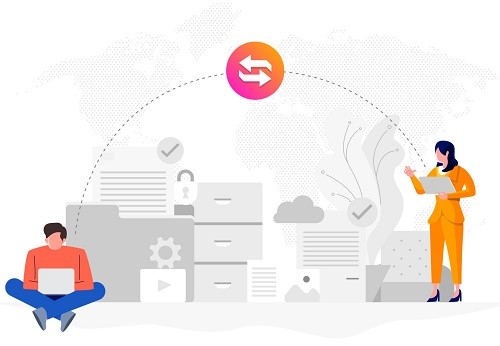Step-by-Step Guide to Cloud Migration

Step-by-Step Guide to Cloud Migration

With the consequences of COVID-19, remote work culture is evolving, and businesses are opting for cloud migration strategy. Many businesses have moved to cloud computing to ensure business continuity in these difficult times. The cloud has seen outstanding growth as it emphasizes more on strategizing, planning, and implementation.
“Over 88% of research respondents mentioned that their organizations already use cloud under one form or another, while many of them plan to increase its usage by February 2021.”
Cloud migration helps businesses to decrease capital investment and operational cost by availing computing resources on the internet based on pay-as-you-use pricing models. Given its gigantic potential for various industries, maximum out of them – like railways, manufacturing, retail, banking, education, and healthcare – are adapting to cloud computing services for optimized and flexible performance.
Still, organizations feel confused when it comes to migrating to cloud computing as a result of the entangled basic procedures of moving the data that is significant, intrinsic, and confidential.
So, to know how you get started, here is the step-by-step guide to cloud migration. But before that let’s understand what cloud migration is.
Cloud Migration: An Overview
Cloud migration is the process of moving applications, data, and different other business elements from on-premise environments to the cloud. Likewise, cloud migration can be defined as the way toward moving applications and data from one cloud platform/vendor to another. Many companies move their applications and data to the cloud to avoid the need to build and maintain an on-premise infrastructure.
“87% of global IT decision-makers agree that the current COVID-19 pandemic will cause organizations to accelerate their migration to the cloud.”
Cloud migration services make an association free of the physical work environment by presenting virtual management of resources. The ‘anytime & anywhere’ access has made migration in cloud computing famous among organizations of all sizes.
Cloud migration has two more interpretations – one is a process of moving from one cloud to another, called cloud-to-cloud migration. Second is a process of moving back to on-premises from the cloud, known as reverse cloud migration.
The cloud development needs planning and the ability to know the procedure to get an effective and fool-proof execution.
How do you Migrate to the Cloud Computing?
Cloud technology should be implemented in a sequence of well-defined steps to guarantee a streamlined transition. Although the cloud migration steps are quite easy, the core procedure depends on the size of your business and the complexities of the legacy infrastructure included.
Here are the seven basic yet important steps that answer how would you migrate to the cloud:
1. Know Your Requirements
To begin with, always keep in mind the size of your business and business goals. You must question yourself or within your organization team to have a clear view on goals that will further help in framing an agile cloud migration plan.

A few of the questions can be:
- Why would you like to migrate to the cloud?
- What do you expect from cloud technology?
- What cloud migration strategies suit your business requirements?
- What are your security, server, and performance prerequisites?
The answers to these queries lie in a comprehensive overview of your current on-premise environment.
2. Search for a Suitable Cloud Services Provider
Survey the various cloud services providers in the market. For example, running a comparison between AWS, Azure, or Google Cloud would be useful as they suit the requirements of all-sized businesses.

Comparisons should be principally based on these parameters:
- Storage capacity they offer
- Price model and adaptability
- Compute of the proposed suppliers
- Markets share and the comparing reach
3. Achieve Cloud Migration Style
Before moving forward with the migration procedure, it gets important to pick an appropriate cloud migration style. Here are three of the most conspicuous ones to look over:
Hybrid Cloud: It is an amalgamation of public, private, or even on-premise server centers.
Single-Cloud: It includes the deployment of a single cloud vendor, which isn’t generally ideal thinking about market dynamics.
Multi-Cloud: It includes the deployment of two or more public cloud providers to help build the best of all world’s situations.
4. Communicate with the Stakeholders
Cloud migration plays a major role in the digital transformation of your organization. A few of the organizations are considering it seriously as it helps to streamline the operational guidelines. It becomes important to communicate successfully about cloud migration for preparing for a smooth transition.
5. Select Cloud Migration Tools
There are various cloud migration tools like SaaS tools, open-source tools, or batch processing tools available in the market to look over. You can likewise select a cloud migration service partner/provider from here to help you with selecting the best tools that can synchronize with your cloud deployment model and strategy.
6. Application and Data Migration
With a cloud migration strategy, organizations can move forward with an effective migration plan. Your technical support team can assist you with the migration, or you can outsource the migration work. Understanding and adhering to security and privacy protocols become essential at this level.
7. Ensure Security and Cloud Management
When the migration is done, you will avail the most out of the performance. Thus, ongoing maintenance of the cloud infrastructure is very important. That is the reason you must evaluate cloud health consistently with the help of cloud monitoring tools.
Here’s what you need to track or monitor:
- Measure uptime performance
- Map memory use for virtual machines
- Identify, analyze, and fix any security and usage gaps
Final Thoughts
Cloud migration is a procedure of migrating your businesses’ legacy infrastructure to the cloud environment. With effective cloud adoption, you can anticipate transforming digital experience, which will benefit your organization as well as your customers.
In this blog, we have covered the seven steps that an organization should follow while migrating to cloud technology. But, before migrating, you must understand cloud computing well and plan as per your business requirements to ensure a smooth transition, maximum uptime, and magnified cloud benefits.
